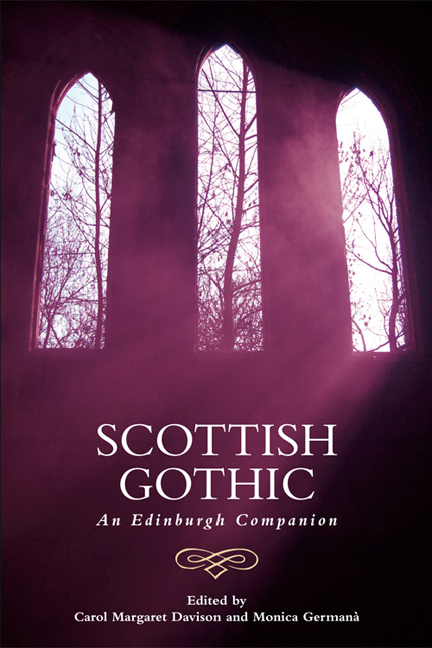Book contents
- Frontmatter
- Contents
- Acknowledgements
- 1 Borderlands of Identity and the Aesthetics of Disjuncture: An Introduction to Scottish Gothic
- 2 ‘The Celtic Century’ and the Genesis of Scottish Gothic
- 3 The Politics and Poetics of the ‘Scottish Gothic’ from Ossian to Otranto and Beyond
- 4 Robert Burns and the Scottish Bawdy Politic
- 5 Scottish Gothic Drama
- 6 Scottish Gothic Poetry
- 7 Calvinist and Covenanter Gothic
- 8 Gothic Scott
- 9 Gothic Hogg
- 10 ‘The Singular Wrought Out into the Strange and Mystical’: Blackwood's Edinburgh Magazine and the Transformation of Terror
- 11 Gothic Stevenson
- 12 J. M. Barrie's Gothic: Ghosts, Fairy Tales and Lost Children
- 13 The ‘nouveau frisson’: Muriel Spark's Gothic Fiction
- 14 Scottish Gothic and the Moving Image: A Tale of Two Traditions
- 15 New Frankensteins; or, the Body Politic
- 16 Queer Scottish Gothic
- 17 Authorship, ‘Ghost-filled’ Islands and the Haunting Feminine: Contemporary Scottish Female Gothic
- Notes on Contributors
- Index
2 - ‘The Celtic Century’ and the Genesis of Scottish Gothic
Published online by Cambridge University Press: 20 December 2017
- Frontmatter
- Contents
- Acknowledgements
- 1 Borderlands of Identity and the Aesthetics of Disjuncture: An Introduction to Scottish Gothic
- 2 ‘The Celtic Century’ and the Genesis of Scottish Gothic
- 3 The Politics and Poetics of the ‘Scottish Gothic’ from Ossian to Otranto and Beyond
- 4 Robert Burns and the Scottish Bawdy Politic
- 5 Scottish Gothic Drama
- 6 Scottish Gothic Poetry
- 7 Calvinist and Covenanter Gothic
- 8 Gothic Scott
- 9 Gothic Hogg
- 10 ‘The Singular Wrought Out into the Strange and Mystical’: Blackwood's Edinburgh Magazine and the Transformation of Terror
- 11 Gothic Stevenson
- 12 J. M. Barrie's Gothic: Ghosts, Fairy Tales and Lost Children
- 13 The ‘nouveau frisson’: Muriel Spark's Gothic Fiction
- 14 Scottish Gothic and the Moving Image: A Tale of Two Traditions
- 15 New Frankensteins; or, the Body Politic
- 16 Queer Scottish Gothic
- 17 Authorship, ‘Ghost-filled’ Islands and the Haunting Feminine: Contemporary Scottish Female Gothic
- Notes on Contributors
- Index
Summary
This may be called the Celtic century, for all Europe has been inundated with nonsense about the Celts. When we come to the truth about them, and time will always draw truth out of the well, the Celtic mist will vanish, or become a mere cloud.
(Pinkerton 1814, vol. 2: 124)The Celtic, insofar as it is applied to Scottish, Irish, Welsh and Cornish identity and culture, is, like traditional Scottish tartans, an invention. Barry Cunliffe describes the word in its current Anglophone usage as an ‘ethnonym’, and dates it to the eighteenth century (2003: 5). Seamus Deane (1997: 77) likewise places ‘Celt’ within scare quotes and suggests it is a late nineteenth- or early twentieth-century term carrying an antimodernist agenda
transposed from its nationalist, antiquarian origins of the eighteenth century into a pan-European combinatoire of evolutionary destiny, the preservation of difference, even of anachronism, as a refusal of those adaptations needed to survive into the world of international capital and the nation-state.
(Deane 1997: 88)The ‘Celt’ and the ‘Celtic’ did not simply emerge in the mid-eighteenth century as an aspect of early Romanticism that reflected the growing literary taste for the ancient British past. Their genesis was instead in antiquarianism, racial politics and national identity, and, as such, the terms are not dissimilar to ‘Goths’ and the ‘Gothic’. The Gothic was politically Whiggish, describing a version of historical progress that was predicated on an irrepressible spirit of liberty that expressed itself through rebellion against tyranny and which was encoded in watershed events of English history: the Magna Carta, the Reformation, the Great Rebellion (the British Civil Wars), the Restoration and the Glorious Revolution. The consequence of all this historical turbulence had been to establish a form of government and civic representation that was liberal, Parliamentary and Protestant – and which underwrote eighteenth-century commercial society and the imperial economy.
- Type
- Chapter
- Information
- Scottish GothicAn Edinburgh Companion, pp. 14 - 27Publisher: Edinburgh University PressPrint publication year: 2017



